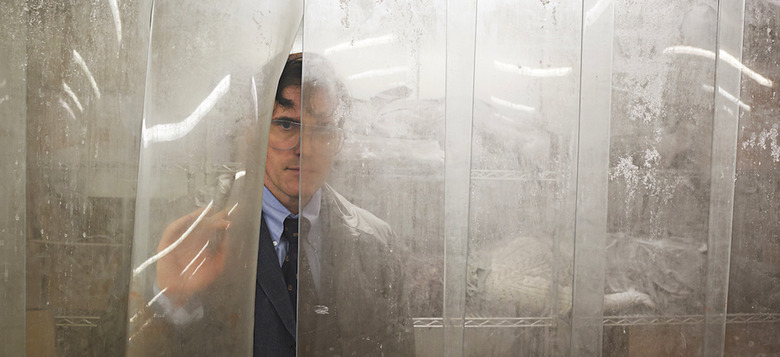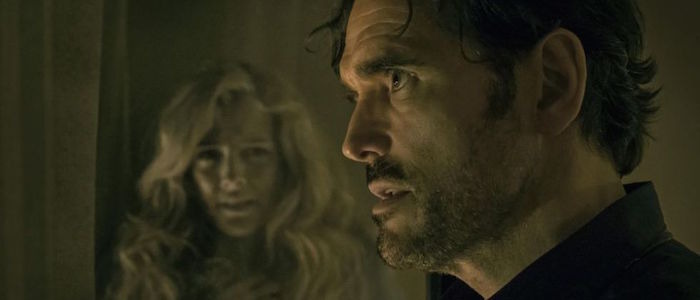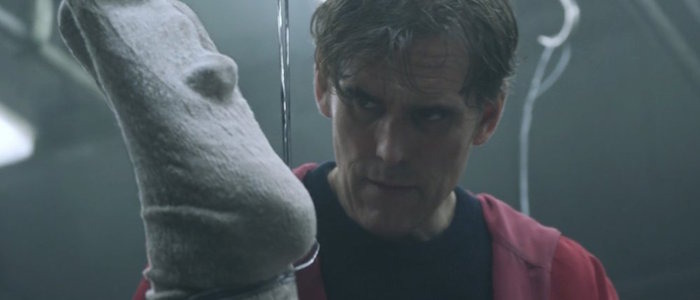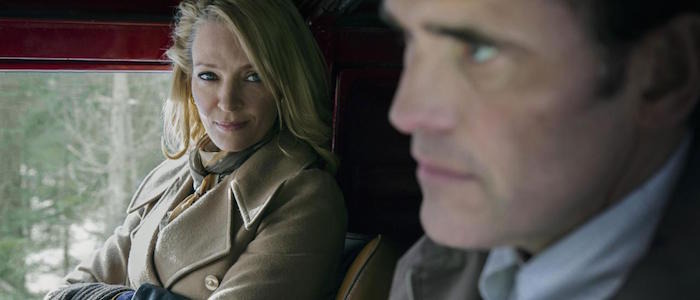'The House That Jack Built' Spoiler Review: A Deep Dive Into 2018's Most Polarizing And Controversial Film
(In our Spoiler Reviews, we take a deep dive into a new release and get to the heart of what makes it tick...and every story point is up for discussion. In this entry: The House That Jack Built.)It's been five years since Lars Von Trier released Nymphomaniac, the bold and astonishing two-parter that figuratively put a period (or exclamation mark, if you rather) on the end of his filmography. Where does a provocateur like Von Trier go from there? What else is left to say? The answer is The House That Jack Built, a deranged, pitch-black comedy (yes, really) that explores the life of a narccisistic serial killer, played by Matt Dillon (again: yes, really).As is typically the case with Von Trier, the story is far more thematically complex and layered than that short synopsis might suggest, and every bit as unsettling and occasionally brutal as you might expect. But is the director's cut – which screened in theaters for one night only – as controversial as some have claimed?Major spoilers to follow.
The Incidents
In predictable Von Trier fashion, The House That Jack Built is divided into chapters – or, as they're presented here, "incidents." Dillon's Jack narrates the story, recounting five "random" incidents that serve as a sort of serial killer portfolio or highlight reel. The first involves a woman (Uma Thurman) who flags Jack down on the side of the road to enlist his help with some car trouble. The woman is somewhat obnoxious and insistent on making Jack go out of his way to help her out, joking at one point that she shouldn't be in his van because he could very well be a serial killer. Jack kills her with the broken jack from her car, ditching her body in a special walk-in industrial freezer he's purchased for body storage.The second incident sees Jack knocking on the door of another woman (Siobhan Fallon Hogan), where he clumsily – and hilariously – delivers some half-baked story about how he's a cop who can help her out with her dead husband's pension. That story quickly crumbles, but the woman is intrigued by the prospect of more cash, so Jack seizes on that angle and claims to be an insurance representative. The woman invites him in and he strangles her, but as it's his first time doing so, he fails to keep his hands around her throat long enough. She wakes up, and he offers her some water with crumbled-up donuts in it, in an attempt to make her choke to death. In what has quickly become a comedy of errors, this plot doesn't work, so he strangles her again. This time, he succeeds. He repositions her body and takes photos before stuffing it in the van.Jack's obsessive compulsive tendencies and anxiety over cleanliness only prolong this incident, which sees him returning to the house multiple times to clean every surface – believing that there's some hidden pool of blood he's not seeing. After a brief and awkward encounter with a snooping cop, Jack hurriedly ties the woman's body to the back of his van and drags her across the concrete behind him, all the way back to his freezer. There's sort of a bonus incident in here, where Jack successfully strangles another woman and, on the way home, runs over an old lady – taking her and the strangled woman back to the latter's apartment to pose them for photos, since he wasn't satisfied with the photos he took after the strangulation. It's around this time that Jack gives himself the serial killer moniker "Mr. Sophistication."The third incident finds Jack attempting to live a somewhat "normal" life, dating a single mother and her two young sons, whom he takes on a picnic trip out to a field. There, he explains that he no longer enjoys hunting, but still lectures the kids on proper gun usage before shooting and killing all three of them. He takes one of the dead sons and, working against rigor mortis, arranges his body so he's smiling and waving. Jack calls this one Grumpy and sets him up in a corner of the freezer like some hilariously grotesque imaginary friend.Incident four is the most disturbing of the five: Riley Keough plays Jacqueline, the only woman Jack ever came close to feeling anything about. He calls her "Simple," and when he visits her place he hobbles along on a crutch – Ted Bundy-style – to make himself appear non-threatening. After coaxing Jacqueline to open up about her insecurities, he exacerbates them by calling her names and drawing around her breasts with magic marker. Following a failed escape attempt, Jack lures her back into the apartment, where she realizes he's cut the phone line. Jacqueline fails to escape again, and Jack cuts off her breasts with a knife. This scene is admittedly exceptionally difficult to watch and may be the reason for so much of the controversy around the film; there is something so specifically misogynistic and horrifying about cutting the female parts of a woman's body – and Von Trier knows this better than most, lest you forget that scene in Antichrist.The fifth and final incident sees Jack comically scrambling to locate and secure a full metal jacket round of ammo. He has detained six people and tied them to a makeshift post, lining their heads up in a row with the intention of killing them all with one bullet. Only a full metal jacket round is powerful enough to do the job. Jack actually doesn't succeed in this mission; in his haste, he grows sloppy, killing a cop and stealing his car, which he leaves – perhaps intentionally – outside his freezer space. It's unclear how Jack dies, but he finally succeeds in prying open a door at the back of the freezer that's always been stuck shut. That door essentially leads him to hell.
Dante’s Inferno
Throughout the film, Jack hasn't exactly been narrating; he's been telling his story to an unseen man named "Verge." Verge is short for Virgil, as in the ancient Roman poet who leads Dante through the various circles of Hell in the meta-text Inferno, by Dante Alighieri. It may be interesting to note that Inferno was merely the first part of Alighieri's epic 14th century poem Divine Comedy – a title that could aptly describe The House That Jack Built, at least in Von Trier's imagination. Given that this is Von Trier's first film post-Nymphomaniac, it's easy to imagine it being the first in a series, thus drawing a parallel between the Danish filmmaker and Dante.Von Trier's film isn't shy about its connections to Inferno, many of which are rather overt. Alighieri's epic describes hell as the realm "of those who have rejected spiritual values by yielding to bestial appetites or violence, or by perverting their human intellect to fraud or malice against their fellow men." But the experience of trudging through the nine circles of Hell is intended as a potentially redemptive one, in which the guilty party recognizes and reflects upon their sins and makes their way toward God. During the film's epilogue, titled "Katabasis" (a reference to the Greek word for a downhill descent), Verge guides Jack down through the realms of Lower Hell. There is a brief intermission scene, in which Von Trier nods to paintings of Charon – the ferryman of Hades – with a slow-moving tableau of Jack and Verge on a boat.When they reach the bottom – or close to it – they come upon a broken bridge. On the opposite side, where the bridge once ended (before Verge's time, he cutely notes) is a stairway to Heaven, where Jack may find redemption after all. Jack breaks from Verge here, and attempts to scale the rocky walls to the other side, but ultimately fails – perhaps because his intentions were not pure, but selfish – and falls into the depths of Hell.
Trump’s America
When I first saw The House That Jack Built some time ago, the metaphors for Trump's America seemed rather obvious, but these are made doubly so by the special introduction Von Trier filmed for the screenings of the director's unrated cut. "Remember," he says at the end, "never again another Trump!" From the outset, Jack tells Verge that he is able to live the life he has by way of a "substantial inheritance," nodding to his awareness of an inherent white male privilege. In some ways, Jack is the poster boy for the far- and alt-right. He ruminates on Adolf Hitler's accomplishments in one darkly comedic sequence (itself a nod to Von Trier's Nazi comments that had him temporarily banned from Cannes in 2011), while Verge – ever the critic and voice of reason – urges Jack to consider a resilient oak tree that stood at Buchenwald and weathered the horrors enacted there.Jack is also a bit of an incel (the internet term for self-styled "involuntarily celibate" men), who obviously hates and resents women. His repeated comedic failures in his various acts of misogynistic killing could be read as symbolic of male sexual impotence. There is also, notably, the third incident, in which Jack places red ball caps on the mother and her sons before donning one himself as he lectures them on the importance and efficacy of guns. In this exceptionally dark comic sequence, Jack declares that he detests hunting and subsequently commits a mass shooting – a horrific act that has become a part of daily life in America, and is almost always committed by a white misogynistic male.
Self-Criticism, Misogyny, and Art
Depiction is not endorsement, and that is perhaps more true for The House That Jack Built than any other film in recent memory. Jack is clearly an avatar for the filmmaker, though it would be far too easy (and lazy, frankly) to interpret anything Jack says as the gospel of Von Trier. There is a distinct vein of self-awareness and, beyond that, self-criticism running throughout the film. Von Trier does not hate women, nor does he condone violence against them. He is not a Nazi. What he is a deeply flawed man struggling to reconcile with his own inherent misogyny – a repeated theme throughout his work. Von Trier does not view Jack – or himself – as heroic or particularly artistic; he finds Jack's "works" laughable and his narcissistic nature pathetic.Take the moment when Jack sarcastically lectures Jacqueline about being a white man in the world. "We're born guilty," he says, before pointing out that women have it so easy because they're always victims, and it's not hard to be a victim. Von Trier is not endorsing Jack's ideology, but mocking it; these statements are clearly absurd, and further satire of the stereotypical repressed white male lurking on the incel subreddit. Verge points out that almost all of the incidents Jack has chosen to recall involve women, and in every instance, Jack portrays them as stupid and helpless – calling into question his unreliable narration. Jack protests that women are just better, more pliant victims, but his misogyny is evident.Jack fancies himself an artist, and arranges the corpses in tableaus that he photographs. He draws a correlation between himself and Hitler, noting that destruction yields perfection, despite Verge's insistence that love – and creation – can also foster great art. "Look at the acts, not the works," Jack says in a fit of narcissistic obliviousness. He scoffs at the notion that art is a way for the artist to work out his demons and darker proclivities as a montage of clips from Von Trier's own filmography plays out on screen, including scenes from Antichrist and Breaking the Waves. In Von Trier's estimation, there isn't much separating the narcissistic serial killer from the egomaniacal artist; both are frustrated by the viewer's inability – or refusal – to interpret the works as they were intended.And yet we see Von Trier's complex relationship with the audience through Verge (or Virgil), who stands as a proxy for the viewer. Verge criticizes Jack's "works" – and his misogynistic "art" – throughout the film, going so far as to deliver meta-remarks such as, "Wasn't Jack going to build a house?" Jack does indeed build a house from his cache of corpses in the freezer, and Verge is seemingly appeased. It is also Verge who encourages Jack to interrogate his evil acts so that by the time they make it to the broken bridge, there is a moment of potential redemption – should Jack, or Von Trier, genuinely take it.Over the years, many have accused Von Trier's films of being misogynistic. The House That Jack Built is an attempt to reconcile with – not justify – that misogyny on his own artistic terms, however sly and satirical. But the comedic elements of his latest work are not symbolic of a man who is not taking his own issues seriously, or who believes the kind of garbage that comes out of his avatar's mouth. He sends himself to the furthest depths of Hell, after all. In that final moment, as Jack tries to find some sort of redemption, it's implied that he fails because he does not come to a genuine understanding of his wrongs; the accountability he takes is self-serving, owning up only to his "art." Maybe inherent misogyny is impossible to eradicate. Maybe trying to reconcile with it is the best he can do; or maybe he enjoys the fruits of this ongoing struggle with himself too much. Maybe there wouldn't be any Lars Von Trier films without it.Perhaps Von Trier has learned nothing. Perhaps he has. But maybe it doesn't matter.




